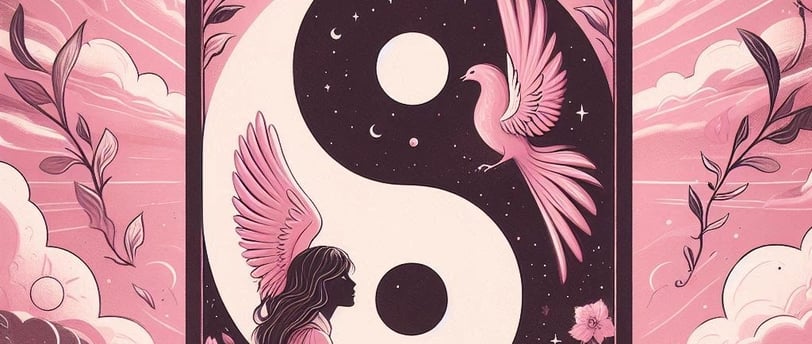The Cosmic dance Part 2 : The Dark Side of Love
Astrology
Effie
2/9/20253 min read


In every relationship, we are drawn to someone who reflects the parts of ourselves that we cannot see—or refuse to see. We often call them our "other half," but if we were whole to begin with, why do we feel this pull toward another person?
The answer lies in the dance between light and shadow, just like the moon—sometimes illuminated, sometimes hidden. When we say someone is our other half, it's because they shine light on the parts of us that remain in the dark.
The Subconscious Mirror in Relationships
Every couple experiences the tension of opposites—the push and pull between two different ways of being. Astrology beautifully illustrates this through opposing houses, which represent different but complementary energies. These dynamics aren’t random; they reveal what our subconscious wants us to embrace within ourselves.
Examples of Opposing Traits in Couples
1. The Control Freak vs. The Free Spirit (6th House vs. 12th House)
- One person thrives on structure, planning, and routines (6H). They need a sense of control to feel secure.
- The other lives in flow, trusting intuition and embracing the unknown (12H). They resist being confined by rules.
- The control freak may feel frustrated by their partner’s unpredictability, while the free spirit may feel suffocated. But deep down, they both long for balance—learning when to surrender and when to take charge.
2. The Chitchatter vs. The Deep Thinker (3rd House vs. 9th House)
- One partner loves small talk, daily news, and staying connected to their immediate world (3H).
- The other is drawn to philosophy, spirituality, and deep, existential conversations (9H).
- The chitchatter may find their partner too serious, while the deep thinker may feel their partner lacks depth. Yet, both need each other—one to stay grounded, the other to expand their mind.
3. The Career-Driven vs. The Family-Oriented (10th House vs. 4th House)
- One person is focused on ambition, success, and public recognition (10H).
- The other finds fulfillment in home, family, and emotional security (4H).
- The career-driven partner might see their family-oriented counterpart as unmotivated, while the family-oriented one may feel neglected. But in reality, both long for a balance between external success and internal fulfillment.
4. The Minimalist vs. The Collector (2nd House vs. 8th House)
- One person values simplicity, minimalism, and financial security (2H). They believe in owning only what they need.
- The other is drawn to depth, transformation, and sentimental possessions (8H). They collect things with emotional or spiritual meaning.
- The minimalist may see their partner as materialistic, while the collector may feel their partner lacks emotional depth. Yet, true balance lies in both—knowing when to let go and when to cherish.
5. The Peacock vs. The Community-Oriented (5th House vs. 11th House)
- One partner loves attention, self-expression, and being in the spotlight (5H).
- The other values group efforts, community, and collective success (11H).
- The peacock may see their partner as dull or uninspiring, while the community-driven one may feel their partner is self-absorbed. But both need each other—one to inspire individuality, the other to remind them they’re part of something bigger.
Love-Hate and the Shadow Self
A love-hate relationship often stems from rejecting a part of ourselves that we see reflected in our partner. We might admire their qualities at first, only to later resent them—because they highlight something we have either suppressed or overemphasized.
For example:
- A free spirit who resents structure might actually need some grounding.
- A deep thinker who rejects small talk might actually crave lightheartedness.
- A career-driven person who dismisses emotional needs might secretly yearn for deep connection.
- A minimalist who judges material attachment might be avoiding their own emotional depth.
- A peacock who craves admiration might secretly long for belonging.
The more we try to push away these aspects, the stronger they manifest in our relationships, creating cycles of attraction, resistance, and entanglement.
Finding Freedom in Self-Acceptance
The next time you feel frustrated with your partner, ask yourself:
- What part of me does this trigger?
- Is this something I have rejected in myself?
- Can I approach this with compassion instead of resistance?
The more you accept your own shadow, the more you can accept your partner. Love is not about eliminating discomfort but about integrating all aspects of ourselves—light and dark—into wholeness. When you release the tension of resistance, you also release the string that binds you to suffering.
Let yourself be everything. Find freedom in your own self-expression.
